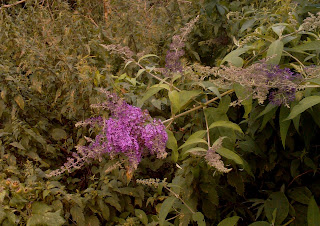I won't give a blow-by-blow account. Suffice to say I saw a significant number of species new to me, both plant and animal, a couple very rare.

 Much of the territory covered - between Ashurst and Beaulieu Road railway stations - was heathland with Ling, Cross-leaved Heath and Bell Heather. I haven't decided whether the small, late-flowering Gorse (in the above picture) is Western Gorse (Ulex gallii) or Dwarf Gorse (Ulex minor). Both occur in the forest. The plants I looked at seemed to have features of both.
Much of the territory covered - between Ashurst and Beaulieu Road railway stations - was heathland with Ling, Cross-leaved Heath and Bell Heather. I haven't decided whether the small, late-flowering Gorse (in the above picture) is Western Gorse (Ulex gallii) or Dwarf Gorse (Ulex minor). Both occur in the forest. The plants I looked at seemed to have features of both.
This is Bog Myrtle .......

and this a late Bog Asphodel .....
 Other plants seen included Sneezewort, Devil's-bit Scabious, Bog Pimpernel, Bogbean and Marsh St. John's-wort (Hypericum elodes).
Other plants seen included Sneezewort, Devil's-bit Scabious, Bog Pimpernel, Bogbean and Marsh St. John's-wort (Hypericum elodes).
Early on in the visit we saw a couple of Stonechat with a Dartford Warbler flitting back and forth in the same area. Dartford is the next station east of where I live, just over the London border in Kent, and the Warbler - which I'd never seen in the flesh before - was the emblem of the erstwhile North Kent Wildlife Preservation Society, which I joined aged 10 in 1970. It was later changed - long before the Warbler started its recent dramatic range expansion - to a Heron to symbolise the North Kent marshes. Perhaps one day it will turn up on Dartford Heath. One was seen at Crossness in Belvedere fairly recently .......
Several Grayling butterflies (below) were seen, a first for me, quite pale on the wing and often gliding - in contrast to other 'Browns'. Once landed on a plant or on the ground they were remarkably amenable to being closely approached .
Another new insect for me was the Keeled Skimmer dragonfly, of which a singleton and a tandem pair were seen.
A big feature of the trip was Orthoptera. The list of species seen is as follows:
- Meadow Grasshopper
- Mottled Grasshopper
- Woodland Grasshopper
- Slender Ground-hopper
- Bog Bush Cricket
- Long-winged Conehead
- and, last but definitely not least, the mighty Large Marsh Grasshopper (Stethophyma grossum) - pictures below - the largest British species, which now occurs only in a very few sites. Several were eventually found very close together after much quartering of a quaking bog for which we'd been given a rough OS grid reference. Ye olde vegan plimsolls are not the best kit for this sort of job, and my feet were still wet when I got home more than three hours later !


Large Marsh Grasshopper - see also http://www.flickr.com/photos/tristanba/4951449849/ which gives a better impression of how bright a yellowish green it can be.
An adult and nymph of the New Forest Shield Bug (Eysarcoris aeneus) were also found in this area - several pictures here http://www.flickr.com/photos/tristanba/4951858637/
Rounding off the trip, a mixed group of House Martins and Swallows were lined up along telephone wires by Beaulieu Road railway station.

















































